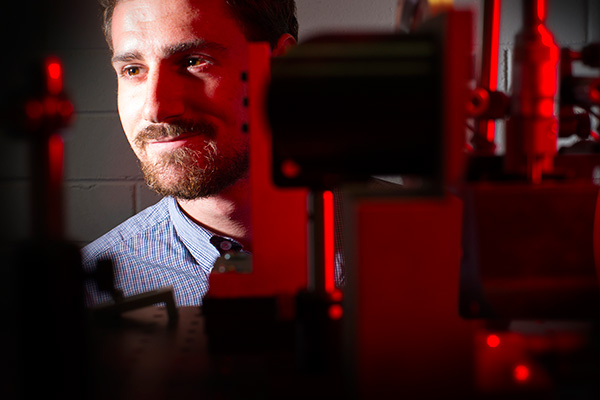August 22, 2014
Shining light on magnetic forces: light and matter in a spin for super electronics
Physicists at UOW have demonstrated a way of measuring magnetic forces using both particles of light and matter, opening up new possibilities for advanced electronics.

Following the development of integrated circuit boards in the 1950s, scientists have been on a quest for electronic devices such as computers that are increasingly smaller, faster and more powerful.
Conventional electronics are driven by pushing atomic particles called electrons around at high speeds in materials such as silicon.
This requires a considerable amount of energy, which generates heat, reducing efficiency and ultimately causing the material to break down and melt, catch fire or otherwise fail.
Recent developments in a field of physics known as spintronics, or spin electronics, have shown that electrons not only have a charge, they also spin, and this process could be used to overcome these limitations.
“The manipulation of the spin of an electron can occur with much less power and at much faster speeds than with its charge and therefore could improve substantially on conventional electronic systems,” Evan Constable, UOW School of Physics PhD student, said.
Researchers first have to build a strong foundation of knowledge about the forces and dynamics of the spins in magnetic materials, which has been so far proved difficult because they occur on a short time scale.
Constable’s recent research, published recently in the journal Physical Review B, has shown how using both light (photons) and matter (neutrons) to interact with the magnetic properties of new materials can reveal important information about the spins, which could one day allow researchers to increase the power and energy efficiency of information processing for computers.
The work combined the use of a low frequency light waves known as terahertz to excite the spin waves in a magnetic material.
“When we performed the experiments, we found that the excited spin waves could teach us about the forces and interactions within the material that govern its magnetization. This is a notoriously difficult thing to do.”
The results were validated using a more traditional method of firing a beam of atomic particles, neutrons, through the material.
“Although similar studies have been performed using these techniques separately, this work makes an effort in pioneering the combination of the two techniques,” Constable said.
“This is significant as it serves as the basis for future experimental and theoretical work invoking these magnetic forces in detail.
In the 60-plus years following the development of the integrated circuit board, fundamental research has enabled an era where millions of people have extremely powerful computers in their pockets that are an essential part of daily life.
“The moral of this story, perhaps, is that research takes time and that the fruits of fundamental studies may not be apparent immediately but could one day have profound effects on society,” Constable said.
“So be sure to thank a physicist next time you pull out your phone to take that selfie.”
Media contact: Evan Constable is available for interview. Please contact Grant Reynolds, UOW Media & PR Officer, on +61 417 010 350 or grantr@uow.edu.au.